Carnets de Géologie / Notebooks on Geology: Book 2009/03, Chapter 6 (CG2009_B03/06)
S.J. (2009).- The Salt Range: Pakistan's unique field museum of geology and paleontology.- In: J.H. & B.R.C. (eds.), PaleoParks - The protection and conservation of fossil sites worldwide.- Carnets de Géologie / Notebooks on Geology, Brest, Book 2009/03, Chapter 6 (CG2009_B03/06)
The Salt Range contains the most important geologic and paleontologic localities in Pakistan, and is one of the outstanding field areas in the entire world. Despite its easy accessibility, it has a wealth of geological and paleontological features. In fact, it represents an open book of geology where various richly fossiliferous stratified rocks are very well exposed due to lack of vegetation. These include the Permian carbonate succession with its outstanding brachiopod fauna, Lower Triassic ammonoid beds (the Mianwali Formation, formerly known as "Ceratite Beds"), and Lower Tertiary marine strata with age diagnostic foraminifera. These rocks also provide an excellent opportunity for appreciation of tectonics in the field. In addition to the easily available roadside geology, some prominent gorges provide fantastic locations to study the sedimentary succession. Older strata are exposed in the eastern Salt Range between the Khewra-Choa Saidan Shah and Fort Kussak including the famous Khewra Gorge. In the west, beyond Kallar Kahar, are younger strata such as in the Nilawahan Gorge at Nurpur, the Nammal Gorge near Mianwali, the Chichali Gorge near Kalabagh, and further west the Lumshiwal Nala at Makerwal. This succession has been rightly called a Field Museum of Geology and Paleontology and can be classified as one of the great paleontological areas of the world, fully worthy of conservation and protection efforts.
Pakistan; Salt Range; geology; paleontology; stratigraphy.
Le Salt Range : un musée de géologie et de paléontologie à ciel ouvert au Pakistan.- Le Salt Range héberge les plus remarquables sites géologiques et paléontologiques du Pakistan, voire même du monde. D'accès facile, sans végétation gênante, ces sites aux thématiques variées sont comme un livre ouvert sur la géologie des roches sédimentaires et leurs fossiles. On y observe une série de carbonates permiens et leur remarquable faune de Brachiopodes, un Trias inférieur à Ammonoïdes (les célèbres "couches à Cératites" de la formation de Mianwali) et un Tertiaire inférieur riche en associations de Foraminifères de référence. La tectonisation de ces couches permet, en prime, d'observer de belles figures de déformation. Précisons que l'observation de ces faits géologiques se fait par de bonnes routes au cœur de gorges très impressionnantes. Les plus anciennes séries sont observables dans la partie orientale du Salt Range entre Khewra-Choa Saidan Shah et Fort Kussak en passant par les gorges de Khewra. A l'ouest, près de Kallar Kahar, les couches les plus récentes s'observent dans les gorges de Nilawahan près de Nurpur, de Nammal près de Mianwali, de Chichali près de Kalabagh. Plus à l'ouest, on visite le Lumshiwal Nala près à Makerwal. Ces sites judicieusement appelés "Musée en plein air de Géologie et Paléontologie" sont reconnus comme l'une des plus importantes zones d'intérêt paléontologique du monde, et méritent tous les efforts possibles de conservation et de développement.
Pakistan ; chaîne du Salt Range ; géologie ; paléontologie ; stratigraphie.
The Salt Range forms the southern border of the hydrocarbon-bearing Potowar Basin in northern Pakistan, along the northwestern margin of the Indo-Pakistani Plate
(Fig. 1 ![]() ). It derives its name from the occurrence of gigantic deposits of rock salt embedded in the Precambrian bright red marls of the Salt Range Formation (formerly known as the "Punjab Saline Series").
). It derives its name from the occurrence of gigantic deposits of rock salt embedded in the Precambrian bright red marls of the Salt Range Formation (formerly known as the "Punjab Saline Series").
Strata in the Salt Range dip northwards into the Potowar Basin where non-marine Tertiary sediments, collectively known as the Siwaliks, are exposed with a wealth of vertebrate fossils. The southern face of the Salt Range is an escarpment that rises abruptly from the Punjab Plains with a junction marked by the Frontal Thurst. Block faulting is the most characteristic tectonic style within the Salt Range.
The Salt Range is essentially an East-West trending elongated narrow trough bounded on the east by the River Jhelum and on the west by the River Indus. Beyond the River Indus at Kalabagh, it takes a sharp turn to run almost in a North-South direction
(Fig. 1 ![]() ). The entire mountainous belt has, therefore, previously been differentiated into the Cis-Indus Salt Range and Trans-Indus Salt Range now known as The Salt Range and Trans-Indus Surghar Range, respectively.
). The entire mountainous belt has, therefore, previously been differentiated into the Cis-Indus Salt Range and Trans-Indus Salt Range now known as The Salt Range and Trans-Indus Surghar Range, respectively.
The Salt Range is one of the most important geological regions in Pakistan. It is easily accessible and displays a wide variety of geological features and paleontological remains. It has, therefore, been rightly called a field museum of geology and paleontology. It represents an open book of geology with richly fossiliferous stratified rocks that include a Permian carbonate succession with brachiopods, Lower Triassic ammonite bearing beds (the Mianwali Formation, formerly known as "Ceratite Beds") and Lower Tertiary marine strata composed of age diagnostic foraminifera. All the strata are excellently exposed due to lack of vegetation. The quality of the exposure also provides excellent opportunities to appreciate tectonic features in the field. The Salt Range is, therefore, of international scientific and educational value, and is highly worthy of conservation and preservation.
In the past, the Salt Range has attracted geologists from all over the world to study Cambrian stratigraphy, the Permian-Triassic boundary, and Lower Tertiary foraminiferal biostratigraphy. Of particular note is the pioneering work of E.R. (1935, 1945), who dedicated almost his entire geological career to the study of the Salt Range. His initial work related to solving the controversy regarding the age of the "Saline Series", a burning topic of that time, and he made a great contribution by producing a geological map (more recently six sheets on a scale 1:50,000 have been published by the Geological Survey of Pakistan excluding the Trans-Indus Surghar Range).
and (1937) completed a comprehensive study of Lower Tertiary larger foraminifera of the Salt Range. (1882-1885, 1895) worked on the brachiopods of the Permian of the Salt Range and (1973) studied the ceratitids of the Triassic of the Salt Range and Trans-Indus Surghar Range. He also worked on stratigraphic nomenclature on the Salt Range as did (1977). and (1966, 1970) illustrated Permian brachiopods and described the detailed stratigraphy of the Permian rocks while (1966) described trilobites. (1956) described the smaller foraminifera from the Tertiary formations of the western Nammal Gorge, Salt Range. (1997) completed his doctoral thesis on the planktonic foraminifera of the Paleogene and established a planktonic biostratigraphy for the Patala Formation of the Salt Range and Surghar Range ( & von , 1991; & , 2000). (1997) completed his doctoral thesis on the Paleogene biostratigraphy of the Salt Range under UNESCO IGCP-286, headed by Prof. Lukas of Basel University, Switzerland, and established an alveolinid biostratigraphy for the Eocene succession of the Salt Range ( & , 1996, 2004; & , 2003). and (1991) worked on the nannofossils of the Patala and Nammal formations of the Khairabad area of the western Salt Range.
The Precambrian rocks exposed in the Salt Range belong to the Salt Range Formation, which contains the thickest (approximately 5000 feet) seams of rock salt in the world. The Salt Range Formation is widely exposed along the southern edge of the Salt Range from east to west and in the Trans Indus Surghar Range. It is also recognized in the subsurface at Dhullian 200 km north of the Salt Range and at Karampur, approximately 500km south of the Salt Range. The Salt Range Formation is divided into three members:
3- Sahwal Marl Member
2- Bandarkas Gypsum Member
1- Billianwala Salt Member
All three members are well exposed on both sides of the Khewra Gorge (Fig. 2 ![]() ). The Billianwala Member contains ferruginous marl and thick seams of rock salt (Fig. 3
). The Billianwala Member contains ferruginous marl and thick seams of rock salt (Fig. 3 ![]() ). One of the largest mines in the world is situated in the town of Khewra
(Fig. 4
). One of the largest mines in the world is situated in the town of Khewra
(Fig. 4 ![]() ) in the eastern Salt Range, where salt is mined by the room and pillar method from 17 floors of the mine. The Bandarkas Gypsum Member contains marl and huge deposits of crystalline and non-crystalline gypsum
(Fig. 5
) in the eastern Salt Range, where salt is mined by the room and pillar method from 17 floors of the mine. The Bandarkas Gypsum Member contains marl and huge deposits of crystalline and non-crystalline gypsum
(Fig. 5 ![]() ). The Sahwal Marl Member contains marl along with 8-10 feet thick seams of rock salt. At the top of this member in the Khewra area, an igneous volcanic body is exposed known as ‘Khewrite', which resembles an igneous body that occurs with the Pre-Cambrian Harmuz Salt of Iran. The sharp contact between the Salt Range Formation and the overlying Cambrian Khewra Sandstone
(Figs. 2
). The Sahwal Marl Member contains marl along with 8-10 feet thick seams of rock salt. At the top of this member in the Khewra area, an igneous volcanic body is exposed known as ‘Khewrite', which resembles an igneous body that occurs with the Pre-Cambrian Harmuz Salt of Iran. The sharp contact between the Salt Range Formation and the overlying Cambrian Khewra Sandstone
(Figs. 2 ![]() & 6
& 6 ![]() ) can also be observed in the gorge.
) can also be observed in the gorge.
The Paleozoic rocks exposed in the the Salt Range are of Cambrian and Permian age, with no strata representing the Ordovician to Carboniferous systems. The Cambrian sequence comprises four formations:
4- Baghanwala Formation
3- Jutana Formation
2- Kussak Formation
1- Khewra Sandstone
These Cambrian formations contain (apart from other fossils) a wealth of trace fossils, including trails of trilobites and worm tracks. The Khewera Sandstone shows honeycomb weathering, cross-bedding and interaformational folds. The Baghanwala Formation
(Figs. 7 ![]() - 8
- 8 ![]() ), which contains salt pseudomorphs
(Fig. 9
), which contains salt pseudomorphs
(Fig. 9 ![]() ), is well exposed along the roadside and displays a sharp unconformable upper contact with the overlying Permian glacial deposits.
), is well exposed along the roadside and displays a sharp unconformable upper contact with the overlying Permian glacial deposits.
The Permian strata of the Salt Range are assigned to two groups, the Nilawan Group and the Zaluch Group. The oldest formation of the Permian, the Tobra Formation of the Nilawan Group, is a non-marine deposit that shows different facies across the region. In the eastern Salt Range, it is tillitic (glacially deposited), grading into a marine sandstone; in the central Salt Range it incorporates lacustrine deposits; in the western Salt Range and Trans Indus ranges it displays a complex facies of alternating glacial and stream (ice melt water) deposits. The other formations of the group, the Dandot Formation and Warchha Sandstone, are also well exposed along the Khewra-Choa Saidan Shah road with a sharp contact between them
(Fig. 10 ![]() ).
).
In the central Salt Range near Pail the Amb Formation, the youngest formation of the Zaluch Group, is very well exposed along the roadside, where it contains numerous fusulinid-bearing beds
(Figs. 11 ![]() - 12
- 12 ![]() - 13
- 13 ![]() ). Further west in the Nammal Gorge
(Fig. 14
). Further west in the Nammal Gorge
(Fig. 14 ![]() ), the Wargal Formation (formerly known as the Middle Productus
Limestone) and the Chhidru Formation (formerly known as the Upper Productus
Limestone) are exposed, and bear abundant specimens of Productus and other brachiopods
(Figs. 15
), the Wargal Formation (formerly known as the Middle Productus
Limestone) and the Chhidru Formation (formerly known as the Upper Productus
Limestone) are exposed, and bear abundant specimens of Productus and other brachiopods
(Figs. 15 ![]() - 16
- 16 ![]() ). The Permian rocks have a sharp upper contact with Triassic rocks, marking a paraconformity. The Permian rocks are distinguished by the presence of Productus, whereas the Triassic rocks contains Ceratites.
). The Permian rocks have a sharp upper contact with Triassic rocks, marking a paraconformity. The Permian rocks are distinguished by the presence of Productus, whereas the Triassic rocks contains Ceratites.
The Triassic Mianwali Formation is very well exposed in the Nammal Gorge as well as in the Dhak Pass, where beautiful Ceratites specimens can be found along the roadside
(Figs. 17 ![]() - 18
- 18 ![]() - 19
- 19 ![]() ). The lower contact of the Mianwali Formation with the Permian Chhidru Formation is a paraconformity. The Triassic and Jurassic succession contains both marine and non-marine strata. Amongst Cretaceous rocks, the Chichali Formation (formerly known as the "Belemnite Beds") is very well exposed
(Fig. 20
). The lower contact of the Mianwali Formation with the Permian Chhidru Formation is a paraconformity. The Triassic and Jurassic succession contains both marine and non-marine strata. Amongst Cretaceous rocks, the Chichali Formation (formerly known as the "Belemnite Beds") is very well exposed
(Fig. 20 ![]() ) in the Chichali Gorge (Trans-Indus Surghar Range) where it bears a wealth of belemnites in the form of a "graveyard"; this formation is also exposed in other parts of the Kohat-Potowar basin.
) in the Chichali Gorge (Trans-Indus Surghar Range) where it bears a wealth of belemnites in the form of a "graveyard"; this formation is also exposed in other parts of the Kohat-Potowar basin.
Paleogene rocks are mostly exposed in the central and western Salt Range
(Fig. 21 ![]() ) as well as in the Trans-Indus Surghar Range. These rocks are oil bearing in the adjacent Kohat-Potowar basin, where the Paleocene Lockhart Limestone
(Fig. 22
) as well as in the Trans-Indus Surghar Range. These rocks are oil bearing in the adjacent Kohat-Potowar basin, where the Paleocene Lockhart Limestone
(Fig. 22 ![]() ) acts as a reservoir rock, the Patala Formation as source rock and the Nammal Formation and Sakesar Limestone as cap rocks. The Lockhart Limestone was deposited in a shallow-shelf, marine carbonate environment inhabited by abundant shallow benthic larger foraminifera
(Fig. 23
) acts as a reservoir rock, the Patala Formation as source rock and the Nammal Formation and Sakesar Limestone as cap rocks. The Lockhart Limestone was deposited in a shallow-shelf, marine carbonate environment inhabited by abundant shallow benthic larger foraminifera
(Fig. 23 ![]() ), including guide fossils for the Upper Paleocene such as Miscellanea miscella and Lockhartia haimei. The Patala Formation, of Upper Paleocene and Lower Eocene age, also contains larger foraminifera. The Lower Eocene Nammal Formation and Sakesar Limestone
(Fig. 24
), including guide fossils for the Upper Paleocene such as Miscellanea miscella and Lockhartia haimei. The Patala Formation, of Upper Paleocene and Lower Eocene age, also contains larger foraminifera. The Lower Eocene Nammal Formation and Sakesar Limestone
(Fig. 24 ![]() ) are exposed throughout the Salt Range and Surghar Range, and are rich in age diagnostic larger foraminifera, including Nummulites, alveolinids and assilinids.
) are exposed throughout the Salt Range and Surghar Range, and are rich in age diagnostic larger foraminifera, including Nummulites, alveolinids and assilinids.
The Choegali Formation (formerly known as "Bhadrar Beds"), of Lower Eocene age, is only exposed in the central Salt Range, where it bears age-diagnostic larger foraminifera like Nummulites
(Fig. 25 ![]() ) and alveolinids.
) and alveolinids.
The non-marine Miocene-Pliocene rocks known as the Lower and Upper Siwaliks
(Figs. 26 ![]() - 27
- 27 ![]() - 28
- 28 ![]() ) are famous for their vertebrate fauna including mammals (among which is the largest mammal), birds and reptiles.
) are famous for their vertebrate fauna including mammals (among which is the largest mammal), birds and reptiles.
The Salt Range contains a number of unique fossil occurrences and many occurrences that are useful in research and education. It should be considered carefully by local paleontologists for the preservation and conservation of these resources. Those sites (of any geographic extent) that are deemed worthy of preservation should be designated a potential PaleoPark and local efforts to preserve them should ensue. This will require significant efforts because of the numerous sites, and the size and paleontological fame of the Salt Range.
The author is grateful to Prof. Jere H. for encouragement, guidance and editing, and to Prof. Richard J. for editing the text.
J. (1997, unpublished).- Foraminiferal biostratigraphy and paleoenvironments of the Patala and Nammal formations at the Paleocene-Eocene boundary in the Salt Range and Surgar Range, Pakistan.- Ph.D. Thesis, Punjab University, Lahore, 155 p.
J. & A.A. (2000).- Lower Tertiary planktonic biostratigraphy of the Salt Range, Northern Pakistan.- Neues Jahrbuch für Geologie und Paläontologie, Monatshefte, Stuttgart, Heft 12, p. 721-747.
J. & C.H. von (1991).- Foraminiferal biostratigraphy and paleoenvironmental interpretation of the Paleocene–Eocene Patala and Nammal formations Khairabad East, Western Salt Range.- Pakistan Journal of Hydrocarbon Research, Islamabad, vol. 3, n° 2, p. 61-79.
M. & M. (1991, unpublished).- Nannofossil biostratigraphy of the Patala and Nammal Formations of Khairabad East, Western Salt Range, Pakistan.- Hydrocarbon Development Institute of Pakistan (HDIP), unpublished report.
P. (1967).- Geology of the Khewra Dome.- Proceedings of the 18th and 19th combined session of All Pakistan Science Conference, University of Sind, Hyderabad, Part-III, Abstracts, F3-F4.
B.E. (1970).- Palynology of Permian and Triassic strata in the Salt Range and Surghar Range, West Pakistan. In: B. & C. (eds.), Stratigraphic boundary problems: Permian and Triassic of West Pakistan.- University of Kansas, Special Publication, Lawrence, n° 4, p. 305-453.
M.R. (1974).- Bauxite and clay deposits of a part of Katha-Arara area, Khushab Tehsil, Sargodha Dist. Punjab, West Pakistan.- Pakistan Geological Survey, Information Release, Quetta, n° 76, 21 p.
E.H. (1935).- Siwalik (India) mammals in the American Museum of Natural History.- Transactions of the American Philosophical Society, Philadelphia, (new ser.), vol. XXVI, 401 p.
L.M. & E.S. (1937).- The Eocene beds of Punjab Salt Range.- Memoirs of the Geological Survey of India, Palæontologia Indica, Calcutta, (new ser.), vol. 24, 79 p.
A.N. (1973).- Lithostratigraphic units of Kohat-Potwar Province, Indus basin.- Geological Survey of Pakistan, Memoirs, Quetta, vol. 10, 80 p.
E.R. (1935).- The saline series of north-western India.- Current Science, Bangalore, vol. II, p. 460-463.
E.R. (1945).- The age of saline series of the Punjab and Kohat.- Proceedings of the National Academy of Sciences of India, Calcutta, (Section B), vol. 14, n° 6, p. 269-312.
R.E. (1966).- Late Permian trilobites from the Salt Range, West Pakistan.- Palaeontology, Oxford, vol. 9, Part 1, p. 64-73.
A.F.M. (1956).- The smaller foraminifera of the Ranikot and Laki of the Nammal Gorge, Salt Range.- Geological Survey of Pakistan, Memoirs, Quetta, vol. 1, 300 p.
B. & C. (1966).- Relations between the Permian and Triassic formations in the Salt Range and Trans-Indus ranges, West Pakistan.- Neues Jahrbuch für Geologie und Paläontologie, Abhandlungen, Stuttgart, Band 125, p. 297-333.
B. & C. (1970).- Stratigraphy and paleontology of the Permian-Triassic boundary beds, Salt range and trans-Indus ranges, West Pakistan. In: B. & C. (eds.), Stratigraphic boundary problems: Permian and Triassic of West Pakistan.- University of Kansas, Special Publication, Lawrence, n° 4, p. 1-110.
E.H. (1919).- The early history of the Indus, Brahmaputra, and Ganges.- Quarterly Journal of the Geological Society, London, vol. 75, n° 1-4, p. 138–155.
S.J. (1997, unpublished).- Biostratigraphy of the Eocene succession of the Salt Range, Northern Pakistan.- Ph.D. Thesis, Punjab University, Lahore, 64 p.
S.J. & A.A. (1996).- Use of alveolinids for the recognition of the Paleocene-Eocene boundary in the Salt Range, Northern Pakistan.- In: K., Š. & B. (eds.), International worshop Postojna '96'.The role of impact processes in the geological and biological evolution of the planet Earth.- Scientific Research Centre SAZU, Ljubljana, p. 70-73.
S.J. & A.A. (2004).- Alveolinid biostratigraphy of the Salt Range succession, Northern Pakistan.- Revue de Paléobiologie, Genève, vol. 23, n° 2, p. 505-527.
S.J. & L. (2003).- Elongate and larger alveolinids from Choregali Formation, Bhadrar area, Salt Range, Pakistan.- Pakistan Journal of Environmental Science, 3, p. 16-23.
S.M.I. (1977).- Stratigraphy of Pakistan.- Geological Survey of Pakistan, Memoirs, Quetta, vol. 12, 138 p.
W. (1882-1885).- (Ser. XIII.) - Salt Range fossils. Productus limestone fossils.- Memoirs of the Geological Survey of India, Palæontologia Indica, Calcutta, vol. I, part 4, Brachiopoda, p. 329–770, 62 Pls.
W. (1895).- (Ser. XIII.) - Salt Range fossils. Fossils from Ceratite Formation.- Memoirs of the Geological Survey of India, Palæontologia Indica, Calcutta, (series XIII), vol. II, part I, Pisces-Ammonoidea, 324 p., 40 Pls.

Click on thumbnail to enlarge the image.
Figure 1: Map of the Salt Range, Pakistan (after E.H. , 1919).
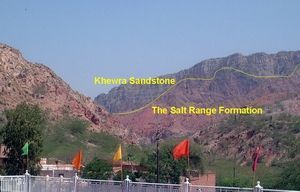
Click on thumbnail to enlarge the image.
Figure 2: Salt Range Formation and Khewra Sandstone exposed in the Khewra Gorge.
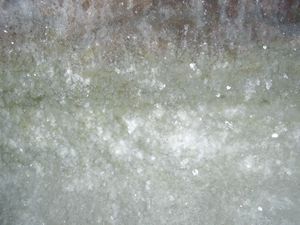
Click on thumbnail to enlarge the image.
Figure 3: Diamond-like salt crystals of the Billianwala Member, Salt Range Formation.
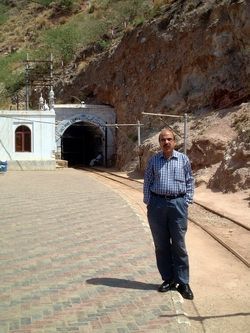
Click on thumbnail to enlarge the image.
Figure 4: Entrance to the Khewra Salt Mine, one of the largest in the world.
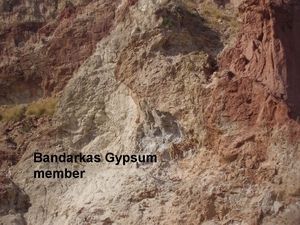
Click on thumbnail to enlarge the image.
Figure 5: Bandarkas Gypsum member of the Salt Range Formation.
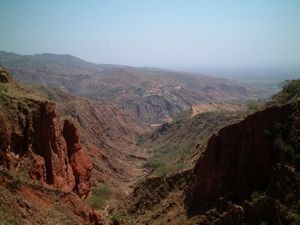
Click on thumbnail to enlarge the image.
Figure 6: Kewra Gorge.
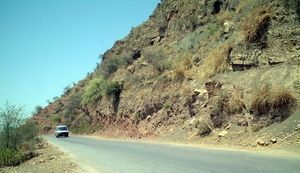
Click on thumbnail to enlarge the image.
Figure 7: Roadside geology showing the contact between the Baghanwala and Tobra Formations in road cuts.
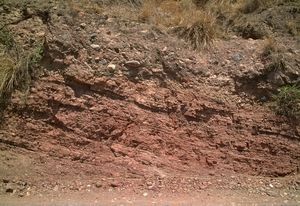
Click on thumbnail to enlarge the image.
Figure 8: Contact between Baghanwala Formation (with salt pseudomorphs) and the overlying Permian glacial Tobra Formation.
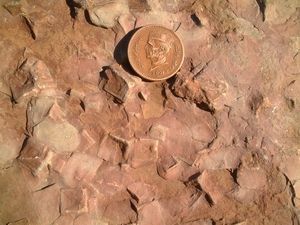
Click on thumbnail to enlarge the image.
Figure 9: Salt pseudomorphs in the Baghanwala Formation.
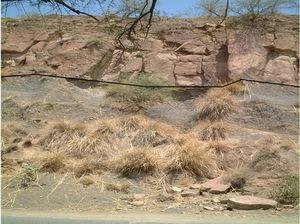
Click on thumbnail to enlarge the image.
Figure 10: The Permian Warchha Sandstone overlying the Dandot Formation exposed along the Khewra-Choa Saidan Shah road.
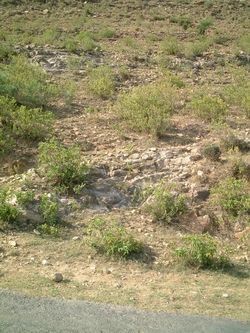
Click on thumbnail to enlarge the image.
Figure 11: Permian Amb Formation, Pail Area.
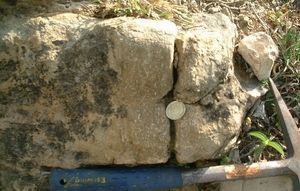
Click on thumbnail to enlarge the image.
Figure 12: Fusulinids beds the Amb Formation, Pail Area.
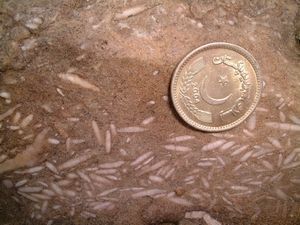
Click on thumbnail to enlarge the image.
Figure 13: Fusulinids in the Amb Formation, Pail Area.
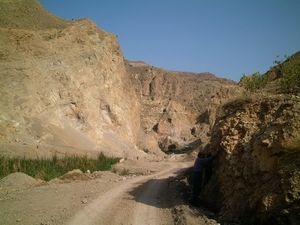
Click on thumbnail to enlarge the image.
Figure 14: A view of Nammal Gorge.
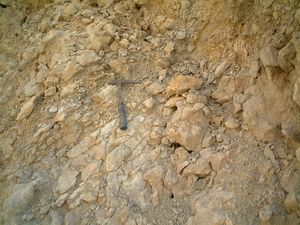
Click on thumbnail to enlarge the image.
Figure 15: Middle Productus Limestone in Nammal Gorge.
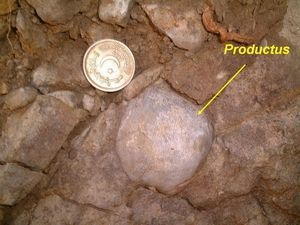
Click on thumbnail to enlarge the image.
Figure 16: Productus exposed in the limestone in Nammal Gorge.
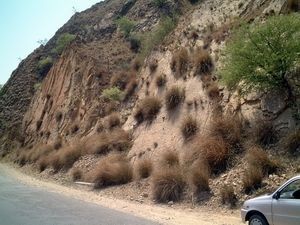
Click on thumbnail to enlarge the image.
Figure 17: Road cuts containing abundant Ceratites at Dhak Pass.
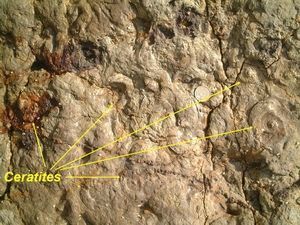
Click on thumbnail to enlarge the image.
Figure 18: Numerous Ceratites exposed on the outcrop.
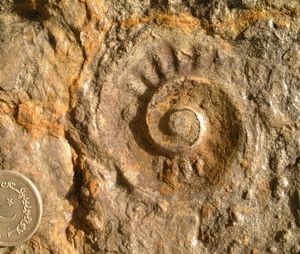
Click on thumbnail to enlarge the image.
Figure 19: A well-preserved Ceratites.
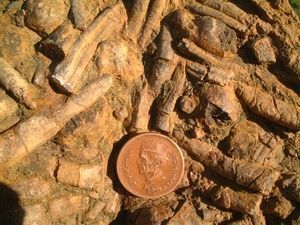
Click on thumbnail to enlarge the image.
Figure 20: Abundant Cretaceous belemnites, known as a "belemnite graveyard", in the Chichali Formation in the Surghar Range.
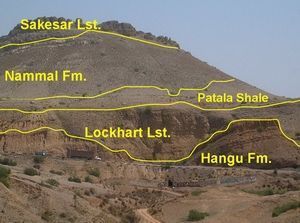
Click on thumbnail to enlarge the image.
Figure 21: Paleogene formations exposed in Nammal Gorge.
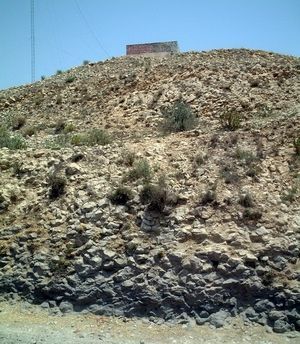
Click on thumbnail to enlarge the image.
Figure 22: The Paleogene Lockhart Limestone exposed along a road side near Nammal Gorge.
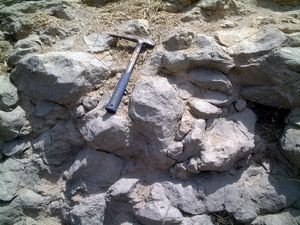
Click on thumbnail to enlarge the image.
Figure 23: Nodular foraminiferal limestone beds in the Lockhart Limestone.
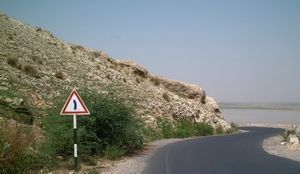
Click on thumbnail to enlarge the image.
Figure 24: Sakesar Limestone.
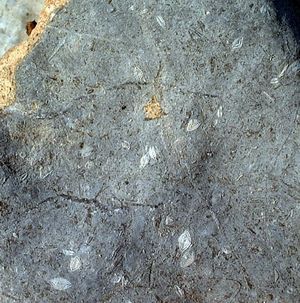
Click on thumbnail to enlarge the image.
Figure 25: The Choegali Formation of Eocene age contains numerous Nummulites, shown in this image.
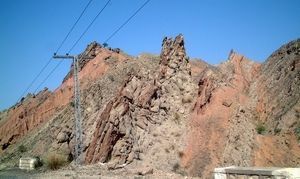
Click on thumbnail to enlarge the image.
Figure 26: The Lower and Upper Siwaliks, non-marine Miocene-Pliocene rocks, occur in the Salt Range.
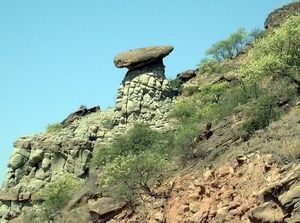
Click on thumbnail to enlarge the image.
Figure 27: Differential weathering and badlands exposures in the Siwaliks.
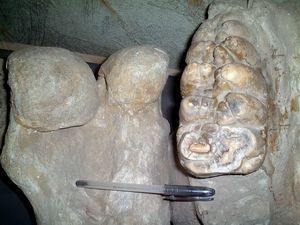
Click on thumbnail to enlarge the image.
Figure 28: Vertebrate fossils are well preserved and abundant at localities in the Siwaliks.